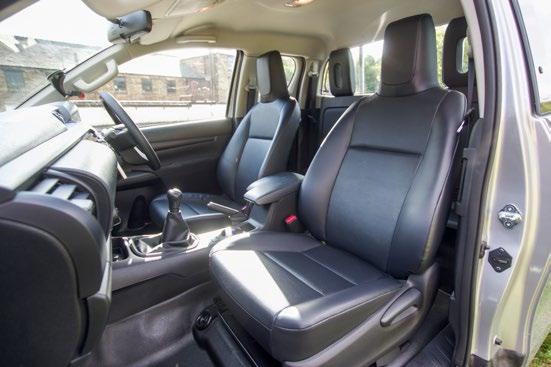
5 minute read
TOYOTA HILUX
Toyota Hilux Active Extra Cab
What is it?
Advertisement
Currently in its eighth generation, and soon to be ninth, the Hilux has been around since Adam was a lad, well, the late 1960s to be precise.
This current generation was launched back in 2015 with the aim of redefining toughness. As well as being tougher, it also boasted ride comfort that made interminable, tough drives less gruelling with a quieter cabin and enhanced cruising range thanks to improved fuel efficiency. The Hilux is available in the UK in six guises, from the basic 2-Door Active, to the top of the range 4-Door Invincible X.

It’s obviously nice have top of the range vehicles delivered to your door every week, but that’s not always what everyone wants, or can afford, so I asked the good people at Toyota if I could borrow their back-tobasic Active Extra Cab.
On the road
Arrival day was a bit of a rush, I had to get home from school and literally grab my overnight bag and camera case, and swap from the comfort of the press Subaru Outback to the Hilux and drive 3 hours and 200 miles down to Abergavenny for a car launch.

Being honest, I expected it to be rough ‘n’ ready on the driving stakes, but it really wasn’t, and from motorways to A roads, the Hilux was quiet, smooth and actually quite relaxing.
From the steering to its suspension, both felt solid and dependable, it isn’t a ‘heavy duty’ feeling as such, but everything feels just right, if you know what I mean.

Ride quality on the majority of roads was good, even whilst unladen, and the 148bhp from the 4-cylinder 2.4 litre lump, although not the quickest, I found more than adequate for what I wanted it for. The 6-speed manual gearbox was maybe a tad truck-like, but there’s a precision to it that’s easy to use, and I warmed to it almost immediately.
Fuel wise, on a decent run that included motorways, A and B roads along proper lowbox technical green laning, I was chuffed that it achieved just over 30mpg, which I thought was cracking.

Off road
To test its off road abilities I drove for 2 hours up to Sellafield towards a lane I hadn’t driven before, one that had a reputation of being quite difficult. I won't go into details here, as you can read more about it on page 72, the Hilux crawled and flexed through the ruts with relative ease, it would have been smoother if I’d had some weight in the back.

In normal road use the Active is rear wheel drive, with a large dial for engaging 4-wheel drive high and 4-wheel drive low and a button for the rear difflock.
The problem with electric modes like this is that they can sometimes take an age to connect and disconnect, and as I reached a tricky part of Bootle Fell, the switching from high to low box took around 5 minutes to engage, which was annoying. It isn’t just the Hilux that has this problem, I’ve waited a similar amount of time in the new L200 and Ranger. The only vehicle in that it worked quickly and seamlessly in was the Land Cruiser Active, which was belting!
Once low box was engaged, the Hilux went everywhere I pointed it, it even surprised me in a few places
Interior
Remember, this is the entry-level Active trim, designed and built for work, not molly-coddling and stroking your ego, so you can expect lots of tough plastics and hard wearing, yet comfy seats.

The centre infotainment screen is again basic, there’s no DAB radio or navigation, you’re limited to an analogue radio and a single CD. All is not lost, mind, you can still plug in your phone using the USB and listen to all your playlists, as well as your phone's sat-nav system through the two speakers.
As well as the 4-wheel drive dials, the heater controls are large chunky too, perfect for when you’re wearing gloves or being thrown about in the quarry.

Despite it’s basic trim, you still get air con, a heated rear window and door mirrors, lockable and cooled glove box and a few other bits that make life comfortable. If I have one criticism, it would be that I really needed the steering wheel to adjust higher, or the drivers seat to be lower, as getting in and out was quite a nuisance for someone with long legs like me. Once behind the wheel though, everything was to hand and perfectly readable with great visibility. If you’re in the habit of man-splaying, then the hard plastic door trim and can become a bit annoying after a while.
Open the rear ‘suicide’ style back doors, and behind the front seats you’ll find a couple of jump seats. I say ‘jump seats’, they’re basically fabric covered sponge pads. The space behind the seats is actually quite decent, I managed to fit my huge 1650 Peli case, camera bags, tripod and the Tyre Table in there with plenty of room to spare. There’s even enough space for my 6ft 2”, 19 stone frame to get in and out with ease. I’m not saying I’d enjoy a long journey back there, but at least I managed to fit.

Conclusion
Apart from getting in and out of the thing, life with the Extra Cab was great. I didn’t even miss the soft plastics on the dash or the heated seats, and after a few days I even got used to not having cruise control!

As a vehicle that I used primarily to go green-laning in, I really appreciated the rubber floor mats, unpainted plastic bumpers and steel 17” wheels that made it all the more practical and rugged.

Once you spend a bit of time driving a Hilux you begin to understand why they’ve been so successful and revered over the last fifty years.
That's right, the Hilux has been around for over half a century, and I have no doubt that it’ll be around for a lot longer still.











